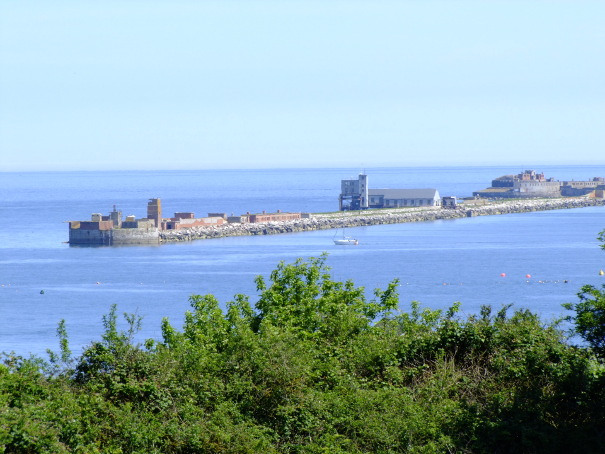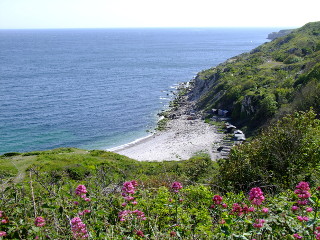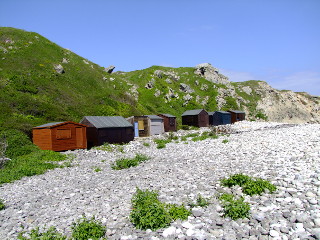Portland Breakwater Picture
Picture of - 'Portland Breakwater'

< < < -- Back to Discovering Portland -- < < <
Portland Breakwater
The Portland Harbour Breakwater can be seen from the Nothe Gardens and Newtons Cove as well as points along the Rodwell trail. In the mouth between the breakwaters is the sunken HMS Hood which was deliberately sunk to prevent submarines entering the harbour during the first world war. Portland Breakwater fort is not open to the public and is not accessible.
Portland Harbour
Portland Harbour is a large harbour that takes advantage of the natural shelter provided by the land borders of Weymouth, Portland and Chesil Beach. Large breakwaters were built to complete the harbour. This large harbour is a popular stop off for cruises which stop in the harbour to allow passengers to explore Weymouth and Portland. Commercial vessels and pleasure boats also use the harbour. Portland Harbour is one of the largest harbours on the South coast and was the largest man made harbour in the world at the time it was built in the Victorian era. It remains the largest man made harbour in the UK to this day.Portland Harbour Shipwrecks
For many centuries, ships have sought shelter in the safety of Portland Harbour. Many ships have floundered around these dangerous coasts, with numerous shipwrecks off the coast of Chesil beach and Portland. Portland harbour has offered safety to many others. Portland Bill lighthouses have provided a beacon that have no doubt kept many a vessel away from the rocks preventing many more shipwrecks around these treacherous waters.Portland breakwater construction
During the 16th century, Henry VIII constructed Portland castle in Castletown and Sandsfoot castle in Weymouth, both to protect the important Portland Harbour from attack. Portland harbour had been a safe refuge for shipping long before this. The Portland harbour breakwaters we see today were constructed a few centuries later in the Victorian era. The convict prison on Portland provided the labour for stone quarrying, used to build the Portland breakwaters. A depiction of a convict quarrying Portland stone is displayed at the Nothe Fort.Portland harbour forts
Portland Harbour has been an important naval harbour for many centuries, there have been a number of defensive forts built around it. As mentioned, Henry VIII had Sandsfoot castle and Portland castle constructed to protect the harbour. In more modern times, the Victorians built the large Verne Citadel high up on the hill at the top of the island. Close by the Verne High Angle battery was constructed to add to Portland Harbour defences. On the Weymouth side, the Nothe Fort was constructed to protect the coast around Weymouth Bay and Portland Harbour, while on the Portland Harbour breakwaters, the small inner pierhead fort and the much larger Portland breakwater fort was constructed.What became of the Portland breakwater forts, Portland Castle and the other fortifications?
Portland castle today is run by English Heritage where it's a popular Portland tourist attraction - one of the best preserved examples of a Tudor fort, it offers great views across Portland harbour. Portland castle can be found at Castletown. Sandsfoot castle is a small ruin set in beautifully kept gardens down towards the bottom of Old Castle road in Weymouth. Close to Sandsfoot castle is the small and sandy Castle cove beach and from here you can see many of the sailing club swinging moorings.Both the Portland breakwater forts are derelict and not accessible to the public, they stand on the Portland breakwaters but they can be seen from viewing points in Weymouth including Newtons Cove and the park above it - from where the picture above of one of the Portland breakwater forts was taken. The Nothe Fort is one of the most popular tourist attractions in Weymouth, it offers outstanding views across Weymouth Bay and out to Portland, it is a large museum of Weymouth history including both world wars, ship wrecks around the coast, torpedo's and guns, life-size displays and a cafe - an excellent way to spend a day in Weymouth.
Portland Harbour in WW1 and HMS Hood wreck at Portland Harbour
Portland harbour was an important naval base and a likely target of attack by enemy submarines in World War 1. To prevent such attacks, the aging 1891 HMS Hood* was scuttled in the southern entrance between the two Portland breakwaters. The dark outline of the HMS Hood wreck between the breakwaters can be seen to this day. *HMS Hood refers to the 1891 ship, the replacement of the same name was sunk by the Bismarck in 1941.Portland harbour in WW2
Like Weymouth, Portland was a large American base in World War II while the harbour was used for embarking American troops for the D-Day landings. As an important naval base, Portland Harbour in WW2 was bombed relentlessly throughout the war and was the scene of one of only 2 Victoria Crosses awarded on English soil. The naval ship HMS Foylebank was heavily bombed in July 1940 by German aircraft, Jack Mantle, a young sailor aboard was mortally wounded during this action but stayed by his gun which he continued to fire until he died from his injuries - an act of bravery that led to the posthumous awarding of the Victoria Cross.Portland Harbour ships
Today Portland harbour remains one of the largest man made harbours in the world offering moorings for ships and boats of all sizes. Cruise ships in Portland harbour are a common sight with Portland being a popular spot for cruise stops in recent years bringing many foreign tourists to the island and the surrounding areas. Portland harbour marina is a large modern marina for local pleasure boats as well as visitors. There are also lots of swinging moorings in Portland harbour offering low cost moorings.

View more things to do in Weymouth
Visit the Nothe Fort
The Nothe Fort is a victorian fort now a museum of life in Weymouth during world war II.
The Nothe Fort is a victorian fort now a museum of life in Weymouth during world war II.
Pirate Graves Church Ope Cove
The Pirates Graveyard at Church Ope Cove on Portland is found high above Church Ope Cove.
The Pirates Graveyard at Church Ope Cove on Portland is found high above Church Ope Cove.
Tyneham Ghost village
Tyneham Ghost Village is a deserted village.
Tyneham Ghost Village is a deserted village.
Things to do in Weymouth in the rain
There are plenty of things to do in Weymouth when it rains and lots more things to do around Dorset too.
There are plenty of things to do in Weymouth when it rains and lots more things to do around Dorset too.
Weymouth History
Did you know that the Black Death arrived in England in 1348 through the port of Weymouth.
Did you know that the Black Death arrived in England in 1348 through the port of Weymouth.
Portland Harbour, Breakwaters and HMS Hood
Portland Harbour History, the Portland Breakwaters, the sinking of HMS Hood and Portland at war.
Portland Harbour History, the Portland Breakwaters, the sinking of HMS Hood and Portland at war.
Just Weymouth - Disclaimer - Contact Us

